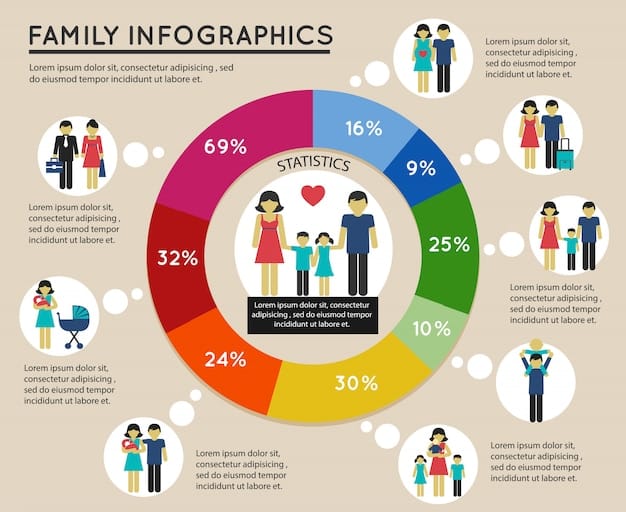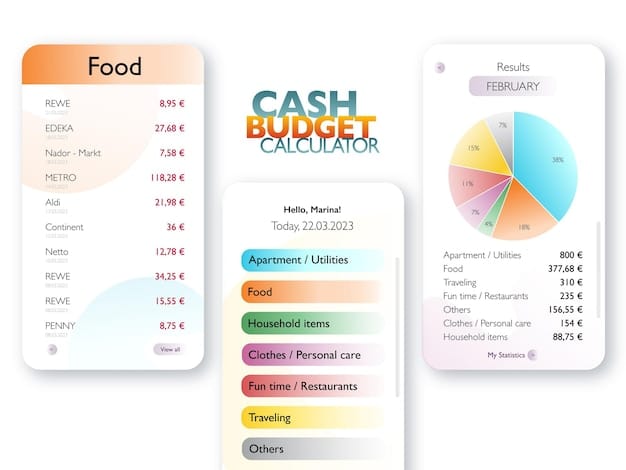Online Shopping Budgeting: Family Tips to Manage Accounts & Purchases

Online shopping budgeting for families involves creating a comprehensive plan to manage multiple accounts and purchases efficiently, ensuring financial stability and avoiding overspending through strategic planning and mindful spending habits.
Managing finances in the digital age can be challenging, especially when it comes to online shopping. For families managing multiple accounts and various shopping needs, creating a solid online shopping budgeting strategy is essential.
Why Online Shopping Budgeting is Crucial for Families
Online shopping has become a staple in modern life, offering convenience and a vast array of choices. However, without proper budgeting, it can quickly lead to overspending and financial strain for families.
Effective budgeting is not just about restricting purchases; it’s about strategic planning to ensure that spending aligns with financial goals and responsibilities.
The Impact of Uncontrolled Online Spending
Uncontrolled online spending can have several negative consequences for families. These include accumulating debt, depleting savings, and creating financial stress within the household.
- Increased debt: Overspending often leads to reliance on credit cards, resulting in high-interest debt.
- Reduced savings: Funds that could be saved for emergencies, education, or retirement are diverted to cover unnecessary purchases.
- Financial stress: Constant worry about finances can strain relationships and negatively impact overall well-being.
Benefits of Effective Online Shopping Budgeting
Implementing a well-structured online shopping budget offers numerous benefits. It helps families gain control over their finances, achieve their financial goals, and reduce stress related to money management.
- Financial control: Budgeting provides a clear overview of income and expenses, empowering families to make informed decisions.
- Goal achievement: With a budget, families can allocate funds towards important goals such as paying off debt, saving for a down payment, or funding a vacation.
- Reduced stress: Knowing that finances are under control can significantly reduce stress and improve overall quality of life.
In summary, proactive online shopping budgeting is a cornerstone of financial health for families. It fosters financial literacy, promotes responsible spending habits, and ensures long-term financial stability.

Setting Up Multiple Accounts for Different Family Needs
When budgeting for online shopping, one effective strategy is to allocate funds into separate accounts tailored to various family needs. This approach provides greater clarity and control over spending, making it easier to track and manage expenses.
Different accounts also help in categorizing expenses, which is essential for effective budgeting and financial analysis.
Creating Separate Accounts
Setting up multiple accounts can be straightforward, depending on the financial institutions used. These accounts can be traditional bank accounts, online savings accounts, or even digital wallets.
Each account should be designated for a specific purpose to avoid confusion and ensure proper tracking.
Examples of Dedicated Accounts
Here are a few examples of how families can set up dedicated accounts for online shopping budgeting:
- Grocery Account: Funds specifically for online grocery shopping.
- Clothing Account: A budget for purchasing clothes online for all family members.
- Entertainment Account: Money allocated for online streaming services, games, and other forms of digital entertainment.
Tools for Managing Multiple Accounts
Several tools can help families manage multiple accounts effectively. These include budgeting apps, spreadsheet software, and online banking platforms.
- Budgeting Apps: Apps like Mint, YNAB (You Need A Budget), and Personal Capital offer account aggregation and expense tracking features.
- Spreadsheet Software: Using programs like Microsoft Excel or Google Sheets to manually track income, expenses, and account balances.
- Online Banking: Utilizing the features of online banking platforms to monitor account activity and set up alerts for overspending.
By setting up and managing multiple accounts strategically, families can gain better control over their online shopping expenses, ensuring that their spending aligns with their financial goals. This approach also makes it easier to identify areas where adjustments can be made to improve budgeting efficiency.
Strategies for Tracking and Categorizing Online Purchases
Tracking and categorizing online purchases is a critical aspect of successful online shopping budgeting for families. Without a clear understanding of where money is going, it’s difficult to make informed decisions and stay within budget.
Efficient tracking and categorization provide valuable insights into spending habits, helping families identify areas where they can cut back and save more.
Manual Tracking Methods
Manual tracking methods involve recording all online purchases in a spreadsheet or notebook. While this approach requires time and effort, it can provide a detailed overview of spending habits.
Key elements to track include the date of purchase, vendor, item description, amount spent, and category.
Automated Tracking Tools
Automated tracking tools, such as budgeting apps and financial software, can streamline the process of monitoring online purchases. These tools often have the ability to automatically categorize transactions, saving time and effort.
- Mint: Automatically tracks and categorizes transactions from linked bank accounts and credit cards.
- Personal Capital: Offers investment tracking and budgeting features, allowing users to monitor their net worth and spending habits.
- YNAB (You Need A Budget): Employs a zero-based budgeting approach, requiring users to allocate every dollar to a specific category.
Tips for Effective Categorization
To ensure accurate budgeting, it’s important to categorize online purchases consistently. Here are some tips:
- Create clear categories: Define specific categories such as “Groceries,” “Clothing,” “Entertainment,” and “Household Supplies.”
- Regularly review transactions: Check transactions regularly to ensure they are correctly categorized.
- Use tags or labels: Many tools allow you to add tags or labels to transactions for more detailed tracking.

By implementing effective strategies for tracking and categorizing online purchases, families can gain valuable insights into their spending habits and make informed decisions about their budget. Whether using manual or automated methods, the key is consistency and attention to detail.
Setting Spending Limits and Using Shopping Lists
Establishing clear spending limits and utilizing shopping lists are essential techniques for maintaining control over online shopping expenses. These methods help families prioritize their needs, avoid impulse purchases, and stay within their budget.
Setting limits and creating lists also promotes mindful spending, encouraging families to consider each purchase carefully before committing to it.
Determining Spending Limits
Setting spending limits involves allocating a specific amount of money to different online shopping categories. This can be done on a monthly or weekly basis, depending on the family’s preferences and financial situation.
Consider factors such as income, fixed expenses, and financial goals when determining spending limits.
Creating and Adhering to Shopping Lists
Creating shopping lists before browsing online can help families avoid impulse purchases and focus on their actual needs. A shopping list should include specific items, quantities, and preferred vendors.
- Plan ahead: Before starting to shop, take an inventory of what you already have and identify what you truly need.
- Prioritize needs: Rank items on your shopping list in order of importance.
- Stick to the list: Avoid deviating from the list unless absolutely necessary.
Tools for Creating and Managing Lists
Various tools can assist families in creating and managing their shopping lists. These include mobile apps, online platforms, and traditional pen and paper.
- Grocery List Apps: Apps like AnyList and OurGroceries allow multiple family members to collaborate on shopping lists.
- Note-Taking Apps: Apps like Evernote and Google Keep can be used to create and organize shopping lists.
- Spreadsheets: Using programs like Microsoft Excel or Google Sheets to create and track shopping lists.
By establishing spending limits and using shopping lists consistently, families can significantly reduce the risk of overspending and ensure that their online shopping aligns with their financial goals. These strategies promote responsible spending habits and empower families to make informed purchasing decisions.
Utilizing Discount Codes, Rewards Programs, and Cashback Offers
Taking advantage of discount codes, rewards programs, and cashback offers is a smart way for families to save money on their online purchases. These strategies can significantly reduce the overall cost of shopping and help families stretch their budget further.
Maximizing savings through discounts and rewards requires some effort, but the potential benefits are well worth it.
Finding and Using Discount Codes
Discount codes are promotional codes that can be applied at checkout to reduce the price of an item. These codes are often available through retailer websites, email newsletters, and coupon websites.
- Coupon Websites: Websites like RetailMeNot and Coupons.com compile discount codes for various retailers.
- Browser Extensions: Extensions like Honey and Rakuten automatically search for and apply discount codes at checkout.
- Retailer Newsletters: Subscribing to email newsletters from favorite retailers can provide exclusive discount codes and promotions.
Leveraging Rewards Programs
Rewards programs allow customers to earn points or cashback on their purchases, which can be redeemed for discounts or other perks. Many retailers offer rewards programs to incentivize repeat business.
Consider joining rewards programs offered by retailers you shop with frequently.
Exploring Cashback Offers
Cashback offers provide a percentage of the purchase price back to the customer after making a purchase. These offers can be accessed through cashback websites, credit cards, and browser extensions.
- Cashback Websites: Websites like Rakuten and Swagbucks offer cashback on purchases made through their links.
- Credit Cards: Many credit cards offer cashback rewards on specific categories of purchases.
- Browser Extensions: Extensions like Honey and Rakuten also offer cashback on eligible purchases.
By actively seeking out and utilizing discount codes, rewards programs, and cashback offers, families can significantly reduce their online shopping expenses. These strategies require some effort and research, but the potential savings can make a real difference to their budget.
Regularly Reviewing and Adjusting the Budget
Regularly reviewing and adjusting the online shopping budget is crucial to ensure it remains effective and aligned with the family’s financial goals and changing circumstances. A budget is not a static document; it should be a dynamic tool that adapts to the evolving needs of the household.
Periodic reviews allow families to identify areas where they are succeeding and areas where adjustments are needed.
Scheduling Budget Reviews
Schedule regular budget reviews, such as monthly or quarterly reviews, to assess the effectiveness of the current budget. During these reviews, analyze spending patterns, identify areas of overspending, and evaluate progress towards financial goals.
Set aside a specific time for budget reviews to ensure they are not overlooked.
Analyzing Spending Patterns
Examine spending patterns to identify trends and areas of concern. Look for categories where spending consistently exceeds the allocated budget and determine the underlying causes.
- Use budgeting apps or spreadsheets to visualize spending data.
- Compare current spending to previous periods to identify changes.
- Look for unexpected or unusual expenses.
Making Necessary Adjustments
Based on the findings of the budget review, make necessary adjustments to ensure the budget remains realistic and achievable. This may involve increasing or decreasing spending limits, reallocating funds to different categories, or setting new financial goals.
- Adjust spending limits based on actual spending patterns.
- Reallocate funds to reflect changes in priorities.
- Set new financial goals or adjust existing ones.
By regularly reviewing and adjusting their online shopping budget, families can stay on track towards achieving their financial goals. This proactive approach ensures that the budget remains a relevant and effective tool for managing online shopping expenses.
| Key Point | Brief Description |
|---|---|
| 💰 Set Limits | Define spending limits for different online shopping categories to avoid overspending. |
| 🛒 Use Lists | Create shopping lists before browsing online to prioritize needs and avoid impulse purchases. |
| ✅ Track Spending | Track and categorize all online purchases to understand spending habits. |
| 🎁 Use Discounts | Utilize discount codes, rewards programs, and cashback offers to save money. |
Ask me Anything
▼
Use budgeting apps like Mint or YNAB, or create a spreadsheet to manually record purchases. Ensure you categorize each transaction accurately to monitor spending habits.
▼
Setting up separate accounts for different needs (groceries, clothing, entertainment) provides better control and clarity over spending. It also simplifies tracking and budgeting.
▼
Create a shopping list before browsing online and stick to it. Avoid visiting shopping websites when you’re bored or stressed, as this can lead to impulse buys.
▼
Budgeting apps such as Mint, YNAB, and Personal Capital are excellent. Browser extensions like Honey and Rakuten can also help find discounts and cashback offers.
▼
You should review your budget at least monthly to assess its effectiveness. Adjustments may be needed based on spending patterns, changes in income, or new financial goals.
Conclusion
In conclusion, effective online shopping budgeting for families requires a combination of planning, tracking, and discipline. By setting up multiple accounts, utilizing shopping lists, leveraging discounts, and regularly reviewing the budget, families can gain control over their online spending and achieve their financial goals.





